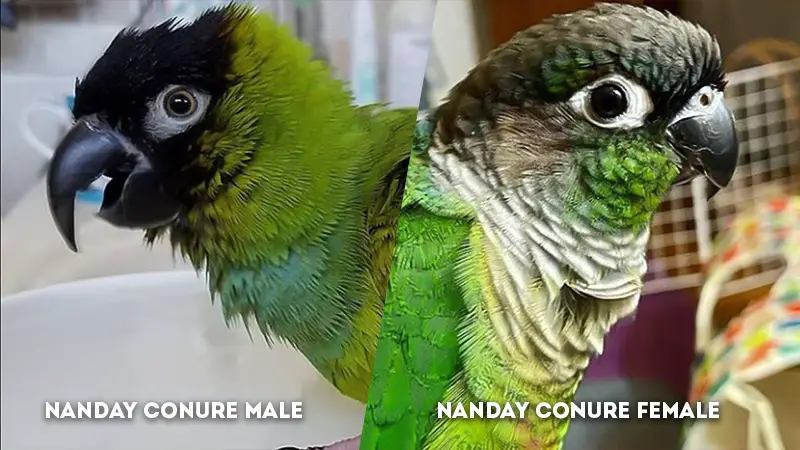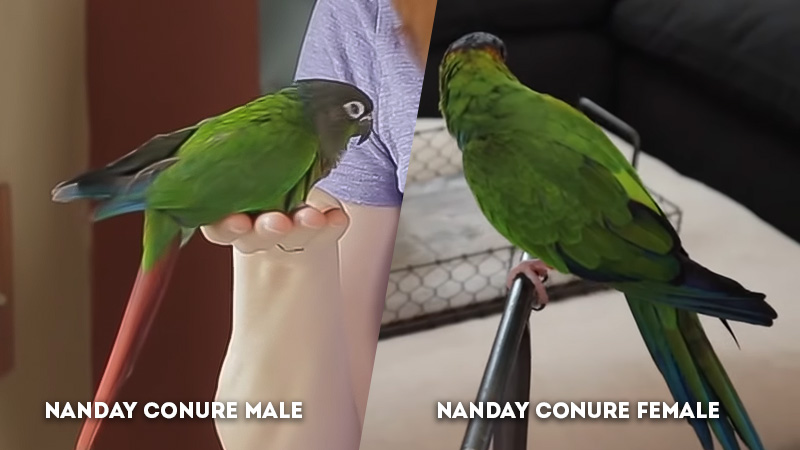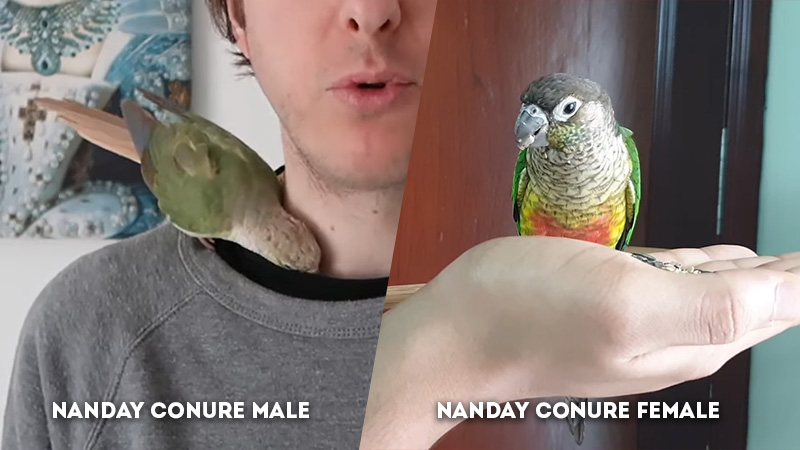The captivating Nanday conure (Nandayus nenday), is a parrot species renowned for its vibrant green plumage, distinct black facial markings, and striking blue wing and tail feathers.
As enchanting companions, Nanday conures have captured the hearts of bird enthusiasts, captivating with their playful demeanor and potential for mimicking human speech.
Within this colorful exterior lies a world of gender-specific traits and behaviors that set male and female individuals apart.
Delving into these distinctions unveils a richer understanding of these avian companions and their unique dynamics, enhancing the bond between bird enthusiasts and these captivating creatures.

Key Differences Between Nanday Conure Male and Female
Nanday Conures are small to medium-sized parrots that are popular as pet birds due to their vibrant colors, playful nature, and ability to mimic sounds. While male and female Nanday Conures share many similarities, there are a few key differences between them:
Size
- Male Nanday Conure: Typically, male Nanday conures exhibit a slightly larger physical size compared to their female counterparts. This difference in size is not always significant, but it is often noticeable upon closer observation.
- Female Nanday Conure: Female Nanday conures are generally slightly smaller than their male counterparts. This size distinction can be more apparent when the birds are observed side by side.
Head and Beak

- Male Nanday Conure: The head and beak of male Nanday conures are characterized by a bolder and more pronounced appearance. The head might seem larger and more robust, and the beak could be thicker in comparison to females.
- Female Nanday Conure: Female Nanday conures, on the other hand, tend to possess a more delicate and refined head and beak structure. These features contribute to their overall appearance of elegance.
Plumage
- Male Nanday Conure: The plumage of male Nanday conures is vivid and captivating, featuring the signature green body coloration, complemented by the striking contrast of black facial markings and the vibrant blue feathers on the wings and tail.
- Female Nanday Conure: Similar to males, female Nanday conures also showcase the distinctive green, black, and blue coloration in their plumage. The patterns and hues are comparable, making plumage an insufficient factor for gender determination.
Facial Markings
- Male Nanday Conure: One of the noticeable distinctions between male and female Nanday conures lies in their facial markings. Male Nandays often display more defined and prominent black facial markings, which can include a striking black mask around the eyes and extending towards the cheeks.
- Female Nanday Conure: Female Nanday conures, while also featuring black facial markings, tend to have facial patterns that are somewhat more subdued compared to their male counterparts. The black markings may be less pronounced, resulting in a slightly softer and more subtle facial appearance.
Wing and Tail Feathers

- Male Nanday Conure: The wing and tail feathers of male Nanday conures are adorned with vibrant blue coloring. These blue feathers stand out against the backdrop of their green plumage, creating a visually striking contrast. The blue feathers on the wings and tail add to the overall allure and beauty of the male birds.
- Female Nanday Conure: Similarly, female Nanday conures also possess the distinctive blue feathers on their wings and tail, creating the same contrast against their green body. This shared feature underscores the challenge of visually distinguishing between male and female birds based solely on plumage.
Behavior
- Male Nanday Conure: The behavioral differences between male and female Nanday conures are often more nuanced.
Males may display more outgoing and vocal behavior, engaging in lively interactions with their environment and human companions. Their playful and energetic demeanor can make them charming and captivating companions. - Female Nanday Conure: Female Nanday conures, while equally engaging, might lean toward a slightly more reserved behavior. They may exhibit a more cautious approach to new experiences or stimuli. However, it’s crucial to note that individual personalities can vary widely within each gender.
Aggression
- Male Nanday Conure: Male Nanday conures can sometimes exhibit territorial and aggressive tendencies, especially in multi-bird setups or when protecting their environment. This behavior is often associated with their more assertive nature and their desire to establish dominance within their social group.
- Female Nanday Conure: Female Nanday conures tend to display fewer aggressive behaviors compared to males. Their interactions with other birds and humans may lean more toward cooperation and companionship. However, it’s important to remember that temperament can differ significantly among individuals.
Social Interactions
- Male Nanday Conure: The social interactions of male Nanday conures often exhibit assertiveness. They may engage in more assertive behaviors when interacting with other birds or even human companions.
This can include playfully challenging behaviors, vocal interactions, and enthusiastic participation in group activities. - Female Nanday Conure: Female Nanday conures may display more cooperative social behaviors. They might engage in interactions that are less confrontational and more harmonious, often seeking companionship and shared activities with their fellow birds.
Vocalizations
- Male Nanday Conure: Male Nanday conures tend to be more vocal, expressing themselves through a broader range of calls, squawks, and whistles. Their enthusiastic vocalizations can make them stand out in a group and contribute to their lively and engaging presence.
- Female Nanday Conure: Female Nanday conures, while also capable of vocalizing, may be slightly quieter in comparison to males. They might use their vocalizations more selectively, often communicating with other birds or expressing their needs in a more subtle manner.
Personality
- Male Nanday Conure: The personalities of male Nanday conures can vary widely, but they often exhibit a playful and energetic demeanor.
Males may be more inclined to explore their environment, interact with toys, and seek out human interaction. Their outgoing and curious nature can make them delightful companions. - Female Nanday Conure: Female Nanday conures may possess a more reserved personality, showing a slightly more cautious approach to new experiences. They might be content observing their surroundings and engaging in activities that align with their comfort level.
Color Intensity
- Male Nanday Conure: Male Nanday conures typically exhibit slightly more intense coloration in their plumage. The green, black, and blue hues may appear slightly more vibrant, contributing to their striking and eye-catching appearance.
- Female Nanday Conure: While equally beautiful, female Nanday conures might display color intensity that is slightly softer in comparison to males. The differences can be subtle, but close observation can reveal variations in color saturation.
Feather Glossiness
- Male Nanday Conure: The feathers of male Nanday conures often appear glossier, reflecting light more prominently. This glossiness can enhance their overall appearance, making them visually captivating and adding to their charm.
- Female Nanday Conure: Female Nanday conures might possess feathers with a slightly less glossy texture. While their plumage is still vibrant and attractive, the glossiness might be less pronounced compared to males.
Mating Behavior
- Male Nanday Conure: Male Nanday conures often exhibit distinct mating behaviors when interacting with females. During courtship, males may engage in elaborate displays such as offering food, dancing, and vocalizing to attract female attention. They play an active role in initiating and participating in the mating process.
- Female Nanday Conure: Female Nanday conures typically exhibit receptive behaviors during courtship. They may show interest in the displays of the males and engage in behaviors that signal their readiness to mate.
Nesting Instincts
- Male Nanday Conure: While both male and female Nanday conures can contribute to nest preparation, males may show a more enthusiastic interest in gathering materials and building nests. They often play an active role in creating a suitable environment for breeding.
- Female Nanday Conure: Female Nanday conures may focus more on nesting activities such as arranging the materials provided by the male or rearranging the nest area to their preference.
Agility
- Male Nanday Conure: Male Nanday conures may demonstrate slightly higher agility during flight and movement. Their physical size and potential for greater muscle mass may contribute to their ability to maneuver with agility and speed.
- Female Nanday Conure: Female Nanday conures, while also capable of agile flight and movement, may exhibit slightly less speed and precision compared to males. This difference might not always be significant and can vary among individuals.
Dominance
- Male Nanday Conure: In multi-bird setups, male Nanday conures might display more dominant behaviors, seeking to establish their position within the social hierarchy. This dominance can manifest in interactions with other birds, especially when it comes to access to resources.
- Female Nanday Conure: Female Nanday conures, on the other hand, tend to exhibit less dominant behaviors in social settings. They may be more cooperative and less interested in asserting dominance over other birds.
Exploratory Behavior
- Male Nanday Conure: Male Nanday conures often exhibit exploratory behaviors with confidence and curiosity. They may eagerly investigate new toys, perches, or objects within their environment, showcasing their adventurous nature.
- Female Nanday Conure: Female Nanday conures might approach exploratory behavior with a slightly more cautious attitude. They may take their time to assess new objects or situations, demonstrating a more measured approach to exploration.
Territorial Behavior

- Male Nanday Conure: Male Nanday conures can exhibit territorial behavior, especially when it comes to protecting their nesting site or favored perches. This behavior might manifest as vocalizations, posturing, or even more assertive interactions with perceived intruders.
- Female Nanday Conure: Female Nanday conures, while also displaying territorial behavior to some extent, might be slightly less prone to engaging in territorial disputes. They may prioritize nesting and raising their young over territorial disputes.
Parental Roles
- Male Nanday Conure: Male Nanday conures often play an active role in parenting, contributing to tasks such as feeding and protecting the chicks. Their involvement in caring for the offspring underscores their commitment to the breeding process.
- Female Nanday Conure: Female Nanday conures usually take on a primary role in incubating the eggs and keeping the chicks warm. They are also actively involved in feeding and nurturing the young birds.
Mate Selection
- Male Nanday Conure: Male Nanday conures engage in elaborate courtship behaviors to attract a potential mate. They may showcase their vibrant plumage, perform energetic displays, and vocalize in a way that demonstrates their interest and fitness.
- Female Nanday Conure: Female Nanday conures, on the other hand, typically exhibit acceptance behaviors when selecting a mate. They may respond to the courtship displays of the males, signaling their willingness to form a pair bond.
Molt Patterns
- Male Nanday Conure: The molt patterns of male Nanday conures can vary depending on factors such as age and overall health. During molting, their plumage might experience changes in color intensity and glossiness.
- Female Nanday Conure: Female Nanday conures also undergo molting cycles, which can impact the appearance of their feathers. Like males, their molt patterns can affect the vibrancy and texture of their plumage.
Voice Imitation
- Male Nanday Conure: Male Nanday conures often exhibit a broader range of voice imitation skills. They may be more adept at mimicking human speech and a variety of sounds, showcasing their vocal versatility.
- Female Nanday Conure: Female Nanday conures might also engage in voice imitation, but their range of sounds may be slightly narrower compared to males. Their vocalization talents might be more focused on specific calls and tones.
Learning Ability
- Male Nanday Conure: Male Nanday conures often exhibit a keen ability to learn and adapt to new experiences. They may be more receptive to training, including tricks, commands, and even mimicking sounds. Their responsive and curious nature contributes to their aptitude for picking up new skills.
- Female Nanday Conure: Female Nanday conures also possess a capacity for learning, but their approach might be slightly more cautious. They may take a bit more time to acclimate to new experiences or commands, showcasing a measured and thoughtful learning process.
Aggression Towards Same Gender
- Male Nanday Conure: Male Nanday conures can occasionally display aggression towards other males, particularly in competitive situations or when establishing dominance within a group. This behavior is often a result of their assertive nature and the desire to secure their position.
- Female Nanday Conure: Female Nanday conures generally exhibit fewer instances of aggression towards members of the same gender. Their social interactions tend to be more cooperative, prioritizing companionship over dominance.
Dna Identification
- Male Nanday Conure: Accurate gender identification can be confirmed through DNA testing. This reliable method involves analyzing the genetic material of the bird to determine its sex, eliminating any ambiguity and providing certainty about the bird’s gender.
- Female Nanday Conure: Similarly, DNA testing is a definitive way to identify the gender of female Nanday conures. This method removes the need for visual or behavioral cues and provides an accurate determination of the bird’s sex.
Breeding Behavior
- Male Nanday Conure: Male Nanday conures participate actively in the breeding process, engaging in courtship behaviors to attract female partners. They contribute to nest building, feeding the chicks, and protecting the nesting site, exemplifying their dedication to the reproductive cycle.
- Female Nanday Conure: Female Nanday conures also play a vital role in breeding. They prepare the nesting area, incubate the eggs, and provide essential care to the hatchlings. Their nurturing instincts are integral to the successful rearing of offspring.
Nanday Conure Male Vs Female: Comparison Table
| Feature | Male Nanday Conure | Female Nanday Conure |
|---|---|---|
| Size | Slightly larger in general | Slightly smaller in general |
| Head and Beak | Bolder, more pronounced head and beak | More delicate or refined head and beak |
| Plumage | Similar coloration and patterns | Similar coloration and patterns |
| Facial Markings | Black facial markings more defined | Black facial markings more subtle |
| Wing and Tail Feathers | Blue feathers on wings and tail | Blue feathers on wings and tail |
| Behavior | May exhibit more outgoing or vocal behavior | May exhibit more reserved behavior |
| Aggression | Can be more territorial or aggressive | Can be less territorial or aggressive |
| Social Interactions | May engage in more assertive interactions | May engage in more cooperative interactions |
| Vocalizations | Might have louder or more frequent calls | Might have softer or less frequent calls |
| Personality | Can vary widely; some males more playful | Can vary widely; some females more reserved |
| Color Intensity | Colors might appear slightly more vibrant | Colors might appear slightly softer |
| Feather Glossiness | Feathers may appear glossier | Feathers may appear less glossy |
| Mating Behavior | Can exhibit courtship behaviors towards females | Can exhibit receptive behaviors towards males |
| Nesting Instincts | May be more interested in nest preparation | May be more interested in nesting activities |
| Agility | Might be slightly more agile in flight | Might be slightly less agile in flight |
| Dominance | Can be more dominant in multi-bird setups | Can be less dominant in multi-bird setups |
| Exploratory Behavior | May explore wider areas more confidently | May explore more cautiously |
| Territorial Behavior | May mark territory more prominently | May mark territory less prominently |
| Parental Roles | Involved in feeding and protecting offspring | Involved in feeding and protecting offspring |
| Mate Selection | May display elaborate courtship behaviors | May display acceptance behaviors towards males |
| Molt Patterns | Molting patterns can vary | Molting patterns can vary |
| Voice Imitation | Might imitate a wider range of sounds | Might imitate a narrower range of sounds |
| Learning Ability | May learn tricks or mimicry more readily | May learn tricks or mimicry at a similar pace |
| Aggression Towards Same Gender | More likely to be aggressive towards other males | More likely to show aggression towards other females |
| DNA Identification | Can be confirmed through DNA testing | Can be confirmed through DNA testing |
| Breeding Behavior | Exhibits courtship behaviors and territoriality | Exhibits receptive behaviors and nesting prep. |
Frequently Asked Questions
No, it’s often challenging to accurately determine the gender of a Nanday conure based solely on their plumage. While there are some general trends in color intensity and patterns, individual variations can make visual identification unreliable.
Yes, there can be differences in toy preferences based on gender. For example, males might enjoy interactive and physically engaging toys, while females might prefer puzzles or toys that stimulate their intelligence.
While females might be less prone to aggressive territorial behaviors, they can still display protective behaviors around their nesting site. Both genders may have individual responses to their environment, influenced by factors such as age and social interactions.
Yes, in general, male Nanday conures tend to have a broader range of voice imitation abilities. They may mimic various sounds, including human speech, environmental noises, and other bird calls, showcasing their vocal versatility.
Yes, in multi-bird settings, males can exhibit more dominant behaviors as they establish their position within the social hierarchy. This dominance might be related to their assertive nature and the need to compete for resources and mates.
To Recap
In the tapestry of Nanday conure intricacies, the subtle yet significant gender differences add depth to our comprehension of these remarkable birds.
Beyond their vibrant plumage and playful antics, recognizing the nuances in behavior, social interactions, and roles enhances our stewardship of these avian companions.
While general patterns illuminate their world, individuality thrives, reminding us that each Nanday conure possesses a unique personality.
By embracing their distinctions and celebrating their quirks, we create an environment where these captivating creatures can truly flourish, enriching our lives and theirs in harmonious companionship.
